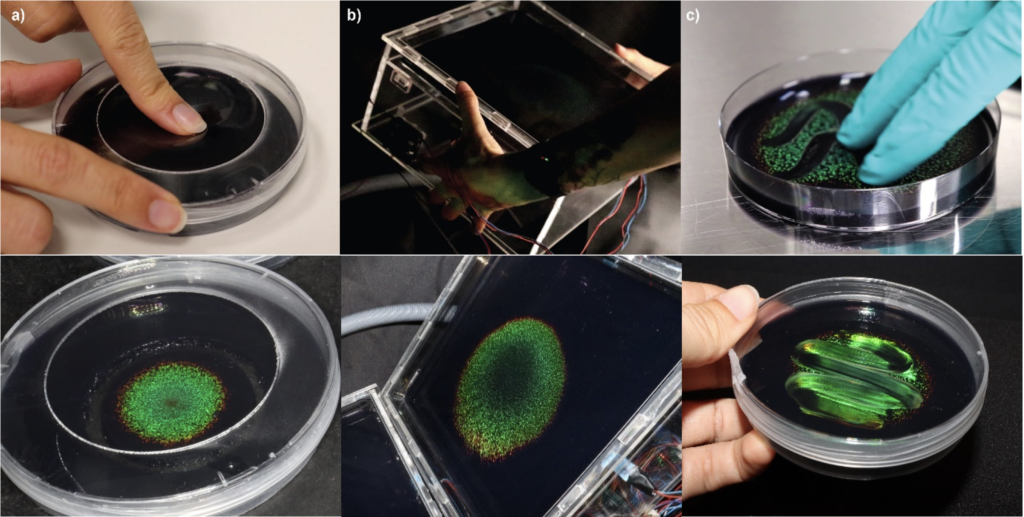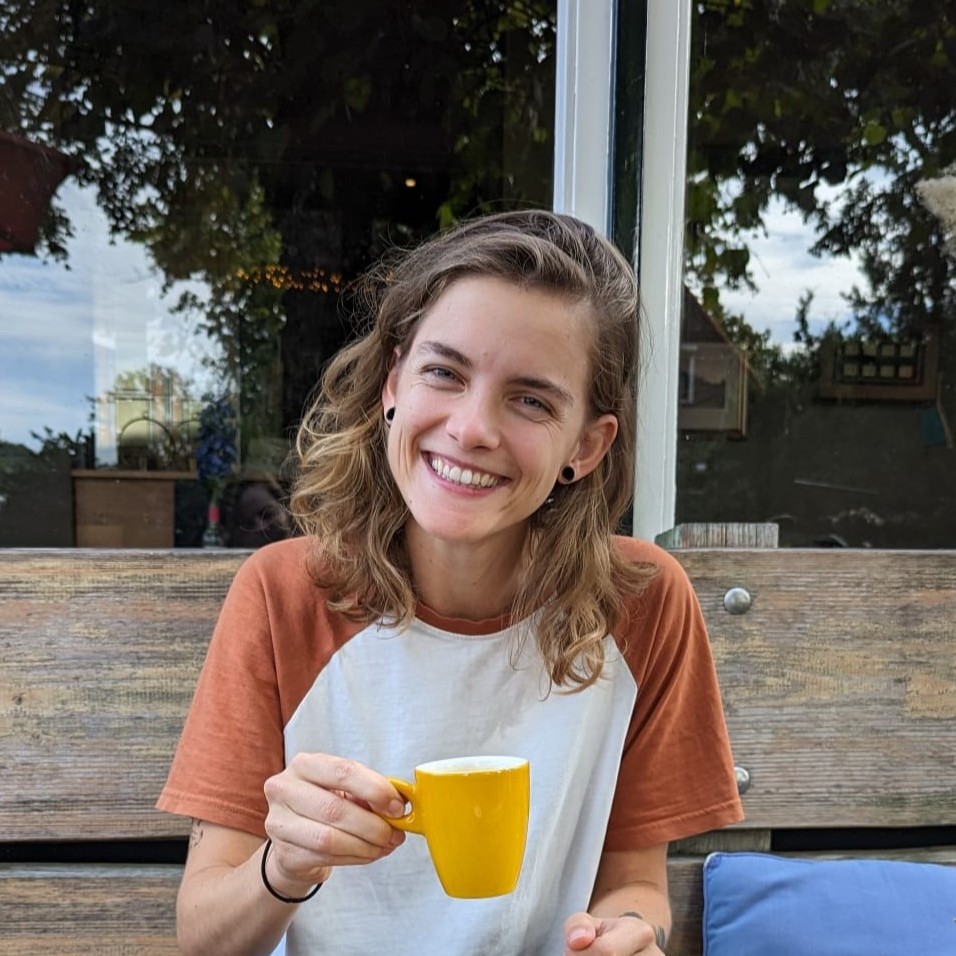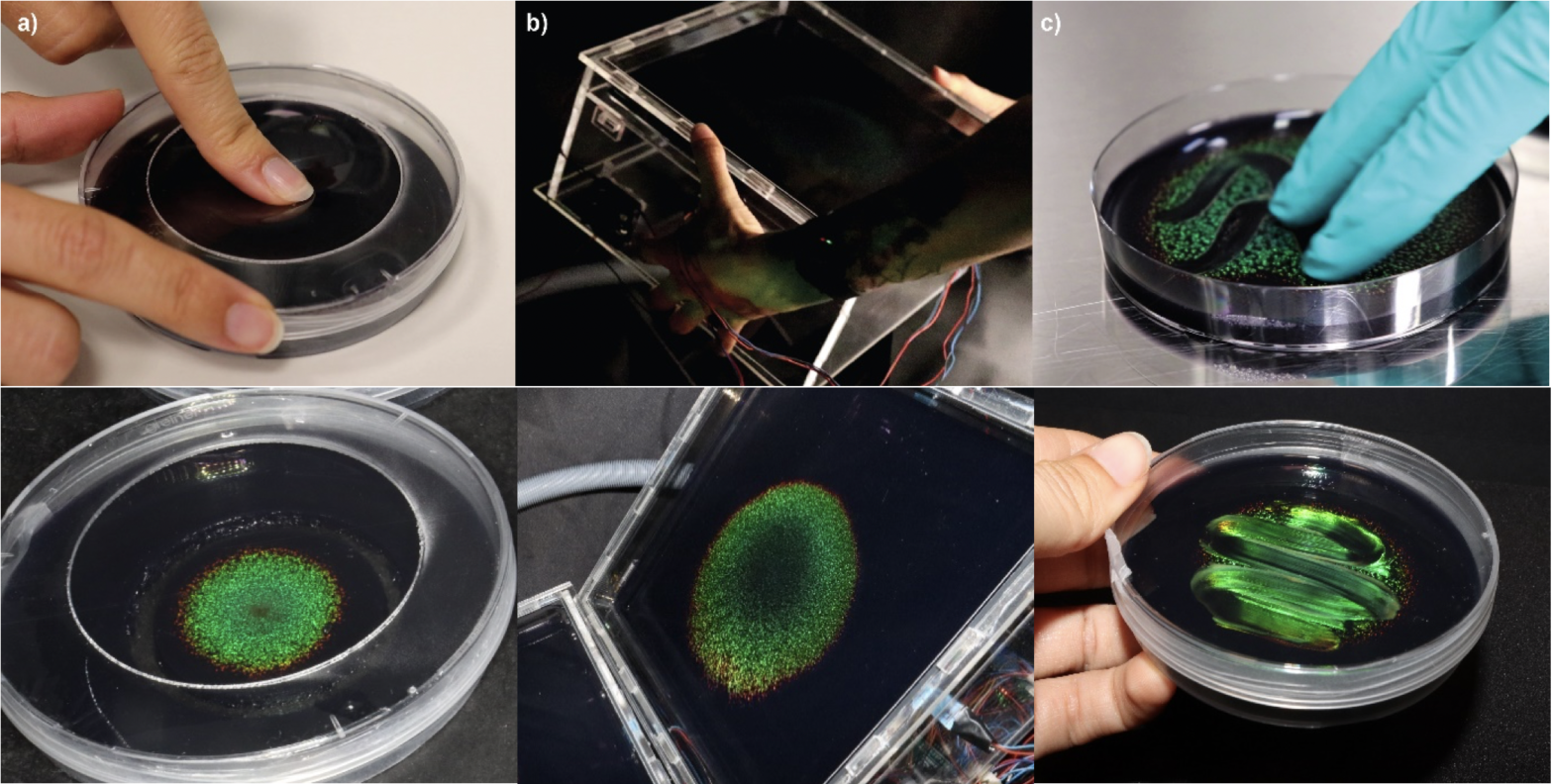We are very pleased to have Clarice Risseeuw showcase her CHI 2024 paper with us, titled “(Re)activate, (Re)direct, (Re)arrange: Exploring the Design Space of Direct Interactions with Flavobacteria”.



Figures of application concepts, in which Flavobacteria act as a qualitative display through a diverse range of grown patina affected by human input, i.e., living traces.
What’s your name?
Hi, my name is Clarice Risseeuw.
Citation:
Clarice Risseeuw, Holly McQuillan, Joana Martins, and Elvin Karana. 2024. (Re)activate, (Re)direct, (Re)arrange: Exploring the Design Space of Direct Interactions with Flavobacteria. In Proceedings of the CHI Conference on Human Factors in Computing Systems (CHI ’24), May 11–16, 2024, Honolulu, HI, USA. ACM, New York, NY, USA, 18 pages. https://doi.org/10.1145/3613904.3642262
TL;DR (if you had to describe this work in one sentence, what would you tell someone?):
Tapping into the potential of direct human-microbe interactions for engagement and attentiveness towards the microbial world, we unveil a design space for direct interactions with structurally-coloured Flavobacteria as well as three studies where we (re)activate, (re)direct, and (re)arrange their living colour.
What problem is this research addressing, and why does it matter?
This research aims to provide pathways and ignite inspiration among HCI designers to create living artefacts that cultivate active engagement and heightened attentiveness towards microbial worlds and beyond. By doing so, we hope to contribute to restoring human-nature interactions and stimulating pro-environmental attitudes and behaviours
How did you approach this problem?
We unpacked direct interactions with microbes through the lens of Flavobacteria. First, we introduce a design space covering the basic architecture and properties of Flavobacteria artefacts, as well as input mechanisms and examples of human input. To illustrate how this design space can inspire a broad array of direct interactions, we selected three human actions to be further explored in our study. Through application concepts, we highlight the potential of such direct interactions for inviting humans to reflect on everyday practices while building awareness and sensitivities towards Flavobacteria’s unique temporalities, needs, aesthetics, and conditions in shared habitats. In our discussion, we critically reflect upon the implications of these interactions.
What were your key findings?
Our study reveals, for the first time, the significant influence of human actions such as pressing, tilting, and swiping on the living colouration of Flavobacteria, underscoring their potential for direct interaction.

What is the main message you’d like people to take away?
The captivating living aesthetics exhibited by microbes can actively engage individuals and enhance their awareness of the microbial world. This potential can be further amplified through direct human interactions with microbes. We encourage researchers in Human-Computer Interaction (HCI) and Design to explore this potential and foster dynamic, reciprocal relationships with living artefacts.
What led / inspired you to carry out this research?
This research was inspired by our previous work on Flavobacteria as well as related work on human-nature engagement and direct interactions with microorganisms.
What kind of skills / background would you say one needs to perform this type of research?
One needs to have patience to (learn how to) work with living microorganisms, as working in a bio lab requires practice and experiments do not always go as expected. Furthermore, one should be open-minded and creative in speculating on exciting futures where we are more integrated with other living entities.
Any further reading you recommend?
- Eduard Georges Groutars, Clarice Risseeuw, Colin Ingham, Raditijo Hamidjaja, Willemijn S. Elkhuizen, Sylvia C. Pont, and Elvin Karana. 2022. Flavorium: An Exploration of Flavobacteria’s Living Aesthetics for Living Color Interfaces. Conference on Human Factors in Computing Systems – Proceedings. https://doi.org/10.1145/3491102.3517713
- Elvin Karana, Bahareh Barati, and Elisa Giaccardi. 2020. Living artefacts: Conceptualizing livingness as a material quality in everyday artefacts. International Journal of Design 14 (2020). Issue 3.
- Elvin Karana, Holly McQuillan, Valentina Rognoli, and Elisa Giaccardi. 2023. Living artefacts for regenerative ecologies. Research Directions: Biotechnology Design 1 (2023). https://doi.org/10.1017/btd.2023.10
- Raphael Kim, Clarice Risseeuw, Eduard Georges Groutars, and Elvin Karana. 2023. Surfacing Livingness in Microbial Displays: A Design Taxonomy for HCI. Conference on Human Factors in Computing Systems – Proceedings. https: //doi.org/10.1145/3544548.3581417
- Clarice Risseeuw, Jose Francisco Martinez Castro, Pascal Barla, and Elvin Karana. 2023. FlavoMetrics: Towards a Digital Tool to Understand and Tune Living Aesthetics of Flavobacteria. Proceedings of the 2023 ACM Designing Interactive Systems Conference, 2079–2092. https://doi.org/10.1145/3563657.3596085
- Netta Ofer, Fiona Bell, and Mirela Alistar. 2021. Designing Direct Interactions with Bioluminescent Algae. DIS 2021 – Proceedings of the 2021 ACM Designing Interactive Systems Conference: Nowhere and Everywhere, 1230–1242. https://doi.org/10.1145/3461778.3462090
Your biography

I am a PhD candidate in biodesign at Materials Experience Lab of Delft University of Technology (TU Delft). My research focuses on exploring the potential of Flavobacteria’s living colour. I obtained my master’s degree in Integrated Product Design as well as my bachelor’s degree from the faculty of Industrial Design Engineering at TU Delft. During my studies in Delft and an exchange programme at the NTNU (Norway), I became increasingly attracted to biodesign, combining my passions for design and nature. I started working with Flavobacteria during my graduation project, in which I characterised and captured this microorganism’s vivid structural colourations. Afterwards, I joined Caradt’s Biobased Art and Design research group and the Material Experience Lab to continue my research. Still amazed by this beautiful microorganism, I started my PhD project with Flavobacteria in March 2022.
✨ Get updates about HCI activities in the Netherlands ✨

